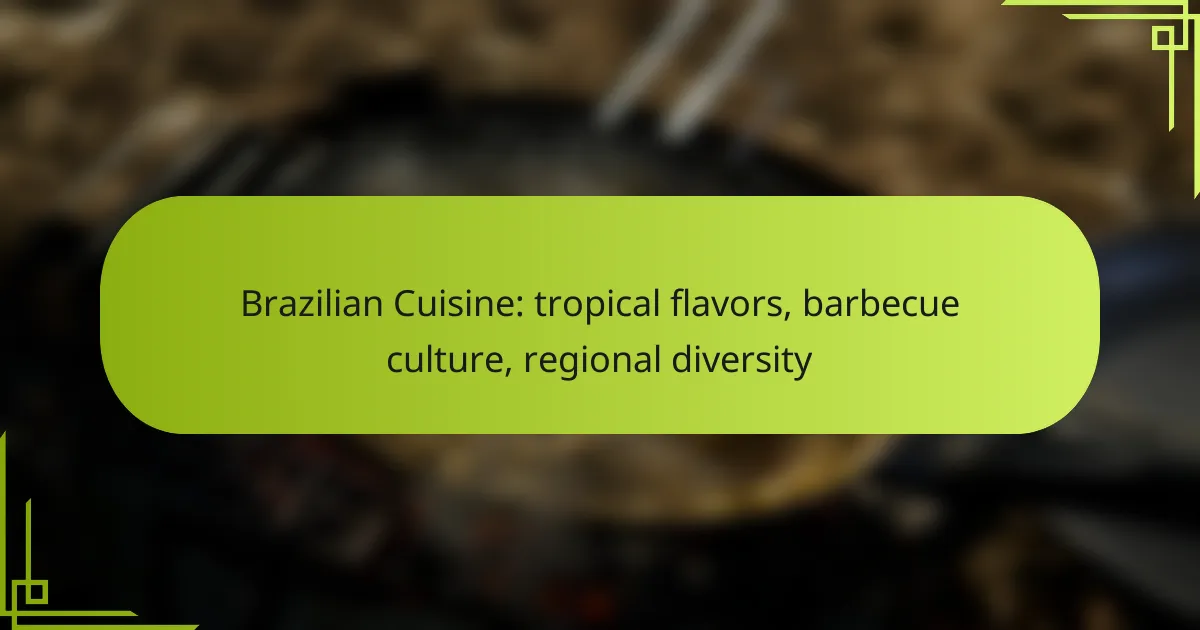Brazilian cuisine is a vibrant tapestry of tropical flavors and regional diversity, shaped by the country’s rich cultural influences. Central to this culinary landscape is the barbecue culture, known as churrasco, where various meats are expertly grilled over open flames, creating distinct and savory profiles. Each region contributes its own unique dishes, showcasing local ingredients and traditional cooking methods that celebrate Brazil’s gastronomic heritage.

What are the key dishes in Brazilian cuisine?
Brazilian cuisine is characterized by its rich flavors and diverse ingredients, reflecting the country’s cultural influences. Key dishes include hearty stews, barbecued meats, and unique snacks that showcase regional specialties.
Feijoada: Black bean stew
Feijoada is a traditional Brazilian black bean stew, typically made with a variety of meats such as pork, beef, and sausage. This dish is often served with rice, collard greens, and orange slices, which help balance the rich flavors.
Originating from the colonial era, feijoada is considered a national dish and is commonly enjoyed during family gatherings and celebrations. When preparing feijoada, slow cooking is essential to develop its deep, savory taste.
Churrasco: Barbecue meats
Churrasco refers to the Brazilian barbecue style, featuring various cuts of meat grilled over open flames or charcoal. Popular choices include beef, pork, and chicken, often seasoned simply with salt to enhance the natural flavors.
This culinary tradition is not just about the meat; it also includes side dishes like farofa (toasted cassava flour) and vinaigrette salsa. Churrasco is a social event, typically enjoyed at gatherings known as “churrascos,” where friends and family come together to savor the food.
Moqueca: Fish stew
Moqueca is a flavorful fish stew that varies by region, with the Bahia and Espírito Santo styles being the most notable. The Bahian version features coconut milk, palm oil, and spices, while the Espírito Santo variant uses olive oil and is often lighter.
This dish is usually served with rice and can include a variety of seafood, such as shrimp or white fish. The combination of ingredients creates a rich, aromatic stew that highlights Brazil’s coastal flavors.
Pão de queijo: Cheese bread
Pão de queijo is a popular Brazilian snack made from tapioca flour and cheese, resulting in a chewy, gluten-free bread. These cheese puffs are typically enjoyed warm and are a staple at breakfast or as an afternoon treat.
They are easy to make at home and can be filled with various cheeses, making them versatile. Pão de queijo is often served at parties and gatherings, showcasing its widespread appeal across Brazil.
Acarajé: Black-eyed pea fritters
Acarajé is a traditional street food originating from the Afro-Brazilian culture, made from black-eyed peas formed into balls and deep-fried in palm oil. These fritters are typically split open and filled with spicy shrimp, vatapá (a creamy paste made from bread, shrimp, and coconut milk), and a pepper sauce.
Commonly found in Bahia, acarajé is often sold by street vendors and is a popular choice for those seeking a flavorful snack. The combination of textures and spices makes it a unique and beloved dish in Brazilian cuisine.

How does barbecue culture influence Brazilian cuisine?
Barbecue culture is a cornerstone of Brazilian cuisine, deeply embedded in social gatherings and culinary traditions. Known as churrasco, this style of cooking emphasizes grilling various meats over open flames, creating a unique flavor profile that reflects regional diversity.
Churrasco as a social event
Churrasco is more than just a meal; it is a vibrant social event that brings families and friends together. Typically held in backyards or at specialized restaurants called churrascarias, these gatherings often involve a variety of meats served on skewers, allowing guests to sample different flavors throughout the evening.
The communal aspect of churrasco fosters a sense of camaraderie, as people share stories and enjoy each other’s company while savoring the grilled delicacies. It is common for these events to last several hours, with food and conversation flowing freely.
Regional variations in barbecue styles
Brazilian barbecue varies significantly across regions, influenced by local ingredients and cultural practices. In the south, particularly in states like Rio Grande do Sul, the emphasis is on beef, often seasoned simply with salt and cooked over wood or charcoal.
In contrast, the northeast region favors a mix of meats, including chicken and pork, often marinated with spices and served with traditional sides like farofa and vinaigrette. Each region’s unique twist on barbecue highlights Brazil’s rich culinary diversity.
Popular cuts of meat used in Brazilian barbecue
Several cuts of meat are staples in Brazilian barbecue, each offering distinct flavors and textures. Picanha, a cut from the top of the sirloin, is highly prized for its tenderness and is often the star of any churrasco.
Other popular cuts include fraldinha (flank steak), costela (beef ribs), and linguiça (sausage). These meats are typically seasoned with coarse salt and grilled to perfection, showcasing the simplicity and quality of Brazilian barbecue.

What are the regional specialties in Brazil?
Brazil’s regional specialties reflect its diverse culture and geography, showcasing a variety of flavors and cooking techniques. Each region offers unique dishes that highlight local ingredients and culinary traditions.
Northeast: Spicy seafood dishes
The Northeast region of Brazil is renowned for its vibrant and spicy seafood dishes, heavily influenced by African and Indigenous culinary traditions. Dishes like moqueca, a fish stew made with coconut milk and dendê oil, and acarajé, a deep-fried ball of black-eyed pea dough filled with shrimp, are popular staples.
When exploring Northeast cuisine, expect bold flavors and a variety of spices. The use of ingredients like malagueta peppers adds heat, while tropical fruits like mango and coconut provide balance. Dining in this region often involves enjoying meals at local markets or beachside stalls.
South: Traditional gaucho barbecue
The South of Brazil is famous for its traditional gaucho barbecue, known as churrasco. This style of cooking involves grilling various cuts of meat, often seasoned simply with salt, over an open flame or charcoal, resulting in rich, smoky flavors.
Churrasco is typically served with side dishes such as farofa (toasted cassava flour) and vinaigrette. In southern Brazil, particularly in Rio Grande do Sul, you can find churrascarias, restaurants dedicated to this barbecue tradition, where servers bring skewers of meat to your table until you signal to stop.
Southeast: Urban street food
The Southeast region, particularly cities like São Paulo and Rio de Janeiro, is known for its dynamic street food scene. Popular items include pastéis, crispy pastries filled with cheese or meat, and coxinhas, chicken croquettes shaped like a teardrop.
Street food in this area is often enjoyed on the go, making it a convenient option for locals and tourists alike. The vibrant atmosphere of street markets and food fairs enhances the experience, allowing you to sample a variety of flavors and dishes in one outing.

How to experience Brazilian cuisine in Canada?
Experiencing Brazilian cuisine in Canada involves exploring authentic restaurants, attending food festivals, and participating in cooking classes. These avenues allow you to savor tropical flavors, barbecue culture, and the diverse regional dishes that define Brazilian culinary traditions.
Top Brazilian restaurants in Toronto
Toronto boasts several outstanding Brazilian restaurants where you can enjoy traditional dishes like feijoada and picanha. Notable spots include Copacabana, known for its vibrant rodizio-style dining, and Bar Bico, which offers a cozy atmosphere and authentic flavors.
When visiting these restaurants, consider trying their specialty cocktails, such as caipirinhas, to complement your meal. Reservations are recommended, especially during weekends, to ensure a table at popular venues.
Brazilian food festivals in Vancouver
Vancouver hosts various Brazilian food festivals that celebrate the country’s culinary diversity. Events like the Vancouver Brazilian Festival feature food stalls offering traditional dishes, live music, and cultural performances, creating an immersive experience.
Attending these festivals is a great way to sample a variety of Brazilian foods in one place. Keep an eye on local event listings to stay updated on festival dates and locations, as they may vary each year.
Online Brazilian cooking classes
Online Brazilian cooking classes provide an accessible way to learn how to prepare authentic dishes from the comfort of your home. Platforms like Udemy and Skillshare offer courses that cover everything from basic recipes to advanced techniques.
When selecting a class, look for those that include ingredient lists and cooking tips to enhance your learning experience. Participating in these classes can also connect you with fellow cooking enthusiasts and expand your culinary skills.

What are the health benefits of Brazilian ingredients?
Brazilian ingredients offer numerous health benefits, primarily due to their rich nutritional profiles and diverse flavors. Many of these ingredients, such as tropical fruits and legumes, are packed with vitamins, minerals, and antioxidants that support overall health.
High nutritional value of tropical fruits
Tropical fruits commonly found in Brazil, such as açaí, guava, and papaya, are known for their high nutritional value. These fruits are often rich in vitamins A and C, fiber, and various antioxidants, which can help boost the immune system and improve digestion.
Incorporating a variety of tropical fruits into your diet can enhance your nutrient intake. For instance, açaí bowls topped with granola and banana provide a delicious way to enjoy these health benefits while also being a popular breakfast option in Brazil.
Benefits of beans and legumes in meals
Beans and legumes are staples in Brazilian cuisine and offer significant health benefits. They are excellent sources of protein, fiber, and essential nutrients, making them a vital part of a balanced diet.
Including beans, such as black beans or lentils, in meals can help regulate blood sugar levels and promote heart health. A traditional dish like feijoada, made with black beans and various meats, showcases how these ingredients can be both nutritious and flavorful.

What are the best Brazilian drinks to pair with meals?
Brazilian cuisine features a variety of drinks that enhance the dining experience, with options ranging from refreshing cocktails to soft drinks. The best pairings often depend on the type of meal, highlighting the vibrant flavors of the dishes.
Caipirinha: National cocktail
The Caipirinha is Brazil’s iconic cocktail, made primarily with cachaça, sugar, and lime. This drink’s sweet and tangy profile complements many traditional dishes, especially grilled meats and seafood.
When preparing a Caipirinha, use fresh limes and adjust the sugar to taste. A typical serving includes one lime cut into wedges, two teaspoons of sugar, and about 50 ml of cachaça, muddled together and served over ice.
Guaraná: Popular soft drink
Guaraná is a beloved Brazilian soft drink made from the guaraná fruit, known for its unique flavor and natural caffeine content. It pairs well with a variety of meals, particularly fried snacks and barbecued dishes.
This soda is often enjoyed chilled and can be found in most restaurants and supermarkets across Brazil. Its sweetness and slight fruity taste make it a refreshing choice for those who prefer non-alcoholic options.










